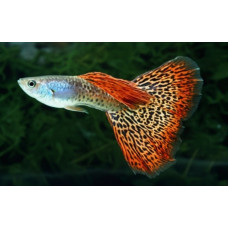Latin name
Poecilia reticulata
Other name
Millionfish or rainbow fish.
Identification
Guppies exhibit pronounced sexual dimorphism, with males and females differing in size, shape, and colouration. Males are slender. The females have an enlarged abdomen in which the eggs are visible.
Features of fish fins
The males have a specialised organ called the gonopodium, which is a phallic-shaped anal fin. Pedigree individuals often have long fins. The fins of females are always smaller in proportion to their body size than those of males.
Fish colouring
Males often have bright colouring. Females from natural habitats and many breeds are grey with a distinct rhombic pattern of scales, after which the species is named: 'reticulum' is Latin for 'mesh' or 'net'.
Distribution
They are widespread in the fresh and brackish waters of Venezuela, Guiana, the northern part of the Amazon and northern Brazil, as well as the islands of Barbados and Trinidad. It has been acclimatised on all continents to control malaria mosquito larvae and is dispersed in warm bodies of water all over the world.
Habitat
The optimal constant water temperature is +24-26 °C (although a range of +23-28 °C is acceptable). Guppies can survive in temperatures ranging from +14 °C to +33 °C. At low temperatures, they grow larger and live for 3–3.5 years, but can easily become ill. At high temperatures, guppies live for one year or less and grow small. The gestation period of females becomes shorter and the fry are born small. When kept in the upper temperature range of 30-33 °C, there is a possibility of 'self-sterilisation' due to a loss of activity and the ability to fertilise sperm. The hardness should be 10-25 °dH and the acidity should be pH 7. Guppies are better adapted to hard water and can tolerate salinity well (adults can be kept in seawater constantly).
Size
The size of the males is 1.5–4 cm. Females are 3-7 cm.
Behavior
These fish do not form swarms or damage plants. They are very peaceful and can coexist with other species of fish. However, it is important to consider that guppies cannot live alone in the long term. Therefore, it is necessary to introduce these fish to the aquarium in pairs or groups.
Food and feeding habits
Omnivorous: requires small food sources of both animal and plant origin. Their main diet consists of plankton, including protozoa, rotifers, crustaceans, mosquitoes, segmented worms, oligochaetes, neuston and lower plants, as well as some algal growths.
Reproduction
Depending on the water temperature, the female's pregnancy lasts between 21 and 40 days. At the end of the gestation period, the female gives birth to between one and 200 fry, depending on her age and size. A single mating is enough for multiple fertilisations: the female gives birth to fry in instalments every one-and-a-half months. There have been repeated cases of females continuing to give birth to fry 12–14 months after mating. Therefore, virgin females are used for breeding and are raised in isolation from males.
Aquarium conditions
Guppies are unpretentious, but they can only reach their maximum bloom under favourable conditions. Offspring of the most pedigree parents will not reach their full brightness or fin splendour in poor conditions. The usual volume for a guppy aquarium is 20–50 litres with a board of about 5–7 cm to prevent the fish from jumping out (if the aquarium is closed with a lid, forced aeration is necessary). Without adequate lighting, guppies, like many other animals, will grow poorly and be poorly coloured in unsuitable living conditions. If you position the aquarium so that it briefly receives direct sunlight in the morning or evening, unpretentious plants will grow well. Guppies are often kept in aquariums with soil (coarse sand or small pebbles) and plants. The decoration should allow enough space for swimming.
| Classification | |
| Phylum | Chordata |
| Class | Actinopterygii |
| Squad | Cyprinodontiformes |
| Family | Poeciliidae |
| Genus | Poecilia |
| Species | P. reticulata |
| Features | |
| Conservation status | Least Concern |
| Habitat | Pelagic |
| Life span, years | 3,5 |
| Maximum body weight, kg | No information |
| Maximum length, cm | 7 |
| Sailing speed, m/s | No information |
| Threat to people | Not edible |
| Way of eating | Predator |
Guppy
Tags: guppy



